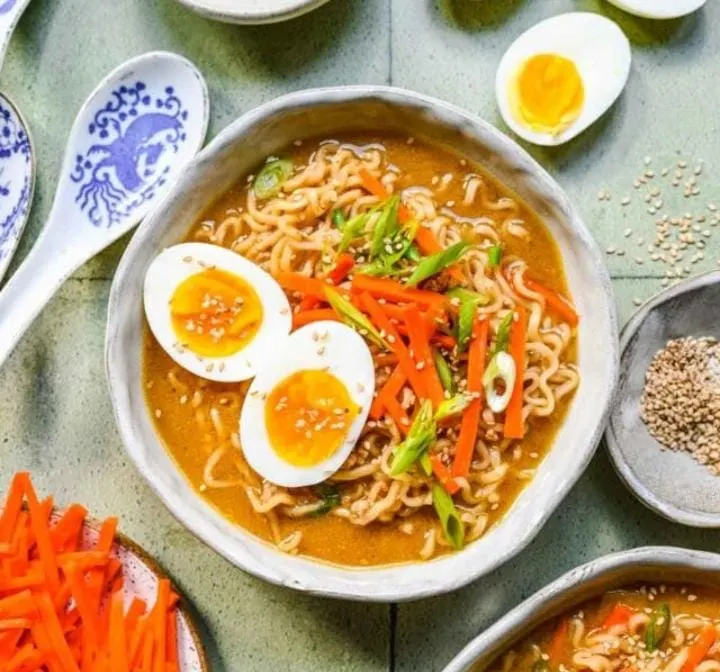Ultimate Homemade Vanilla Coffee Syrup Recipe — Rich, Aromatic & Easy
Vanilla coffee syrup is a versatile, fragrant sweetener that elevates everyday coffee, lattes, cold brews, and desserts. Made from sugar, water, pure vanilla, and a hint of brewed coffee or espresso, this syrup concentrates the familiar warmth of vanilla with the deep, roasted notes of coffee.
When prepared at home you control the sweetness, purity of ingredients, and intensity of coffee flavor. Homemade vanilla coffee syrup transforms plain beverages into café-style creations, and it stores well in the refrigerator for weeks, making it a convenient pantry staple for quick flavor upgrades.
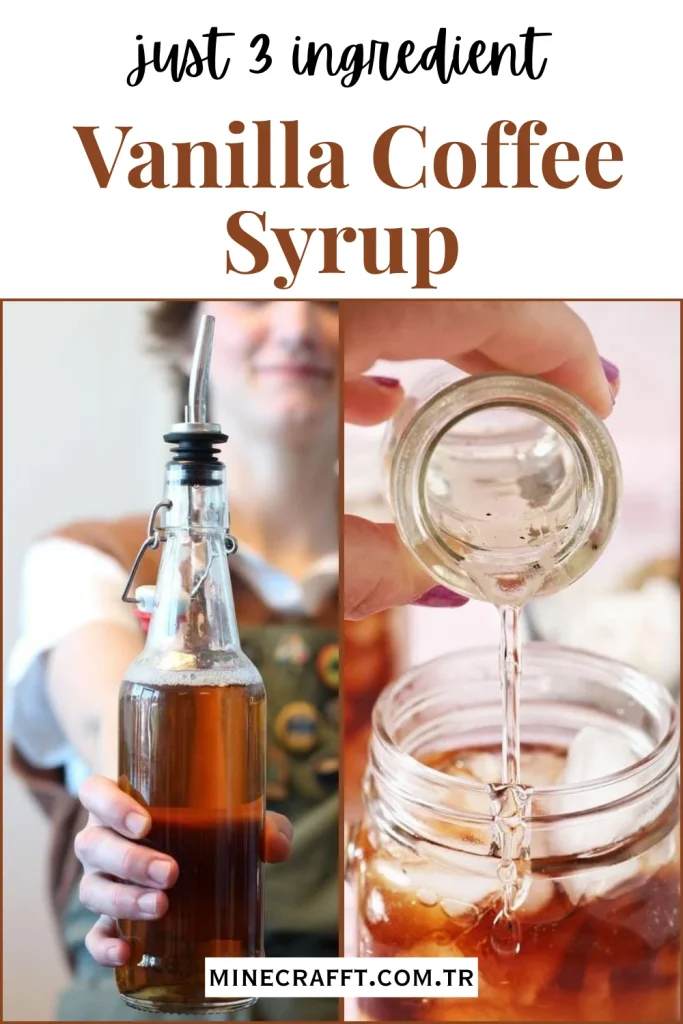
Also read: Homemade Vanilla Syrup
What is Vanilla Coffee Syrup?
Vanilla coffee syrup is a concentrated flavored sugar syrup infused with vanilla and coffee. It is used to sweeten and flavor beverages, desserts, and baked goods. Compared with plain simple syrup, vanilla coffee syrup adds aromatic depth and coffee character, which complements milk-based drinks and iced beverages.
It can be made with instant coffee, brewed espresso, or finely ground coffee steeped and strained, depending on the preferred intensity. The syrup’s sweetness, aroma, and viscosity make it a flexible ingredient for drink menus, home baristas, and creative cooks.

Also read: The Best Cold Brew Coffee Recipe
Nutrients and Main Considerations
Vanilla coffee syrup is primarily sugar and water with flavor extracts; therefore it is calorie-dense and offers minimal micronutrients. A typical tablespoon provides around 50 to 80 calories depending on sugar concentration. Coffee contributes negligible calories but adds flavor compounds and small amounts of antioxidants.
Vanilla extract offers aromatic compounds but no significant nutrients. Use the syrup as a flavoring in small amounts to control added sugars and integrate it into balanced beverages that include protein or fiber to moderate blood sugar response. Choosing high-quality ingredients improves flavor without increasing nutritional burden.
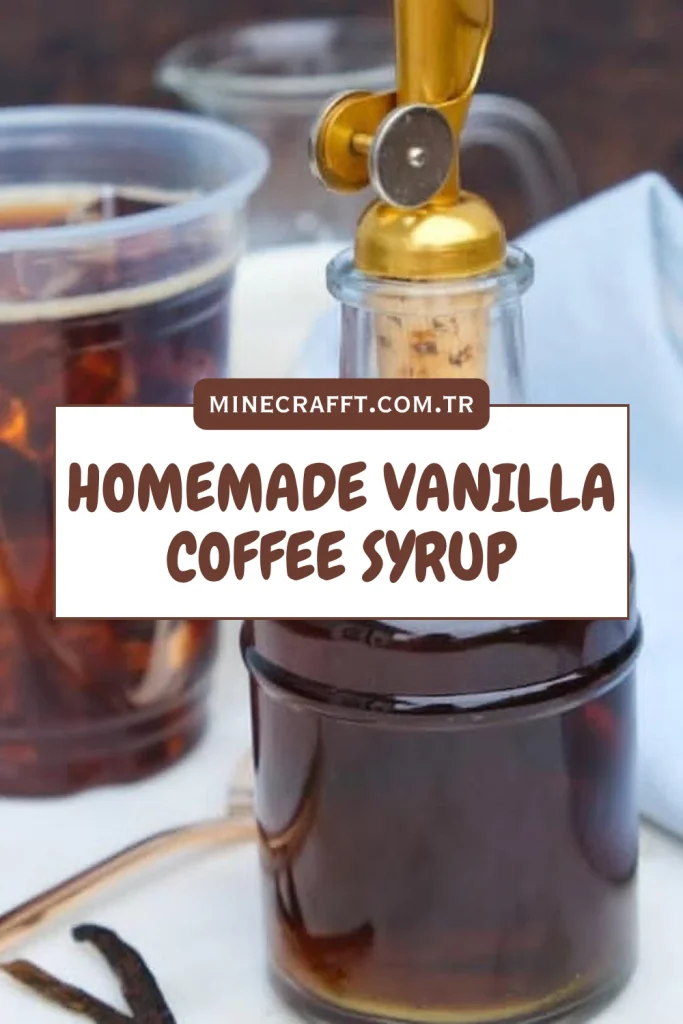
Also read: Best Homemade Caramel Latte Recipe
Main Ingredients (with full explanation and quantities)

Granulated White Sugar
Quantity: 400 grams (2 cups)
Role: Sugar is the structural base of syrup, providing sweetness, body, and preservation. Granulated sugar dissolves into water to create a syrup that suspends and conveys vanilla and coffee flavors. Use white sugar for a neutral, clear syrup; brown sugar adds molasses notes and color. The sugar-to-water ratio determines thickness: this recipe targets a pourable, viscous syrup rather than a jammy reduction.
Filtered Water
Quantity: 480 milliliters (2 cups)
Role: Water hydrates sugar to create a syrup. Filtered water ensures purity of flavor and prevents off-tastes that can occur from chlorinated tap water. The ratio of sugar to water determines viscosity and shelf life. Using clean water also avoids cloudiness and keeps the syrup visually appealing.
Pure Vanilla Extract or Vanilla Bean
Quantity: 2 tablespoons pure vanilla extract, or 1 whole vanilla bean (split and scraped)
Role: Vanilla provides aromatic sweetness and depth. Pure vanilla extract made from real beans yields the cleanest, most complex flavor. A split bean yields intense, natural vanilla oil and tiny seeds that visually enhance the syrup. If using a vanilla bean, macerating it in sugar before dissolving improves extraction of volatile compounds.
Also read: 20 Easy Homemade Protein Coffee Recipes
Coffee or Espresso
Quantity: 60 milliliters (1/4 cup) strongly brewed espresso or 2 tablespoons instant espresso dissolved in hot water
Role: Coffee imparts roasted, bitter-sweet notes that balance the syrup’s sugar and amplify the coffee-forward flavor. Use a concentrated brew to ensure the coffee does not dilute sweetness. Brew strength matters: a robust espresso or concentrated cold brew adds the characteristic roasted aroma without watering down the syrup.
Light Corn Syrup or Glucose (Optional)
Quantity: 1 tablespoon (optional)
Role: Corn syrup stabilizes crystallization and maintains a glossy texture, which is useful if the syrup will be stored long-term or used in cold drinks. It is optional; syrup can be made without it. Glucose or invert sugar performs similarly and is especially helpful when syrups are used in refrigeration or in recipes subject to crystallization.
Salt
Quantity: Pinch (about 1/16 teaspoon)
Role: A small pinch of salt enhances perceived sweetness and balances flavor. Salt brightens vanilla and coffee nuances, requiring only a very small amount to be effective.
Alcohol or Preservative (Optional)
Quantity: 1 teaspoon vodka or 1/4 teaspoon citric acid (optional)
Role: A small alcohol addition preserves flavor and stability; citric acid slightly lowers pH for preservation. These are optional and used sparingly. Alcohol is useful for long-term gifting, as it can help maintain aroma and extend an unopened bottle’s shelf life.
Total Yield
This recipe yields approximately 720 milliliters (about 3 cups) of vanilla coffee syrup, enough for roughly 48 tablespoons of flavored syrup — sufficient to sweeten multiple servings of coffee or to use as a dessert drizzle. Exact yield will vary slightly with evaporation during simmering and any straining losses if solids are removed.
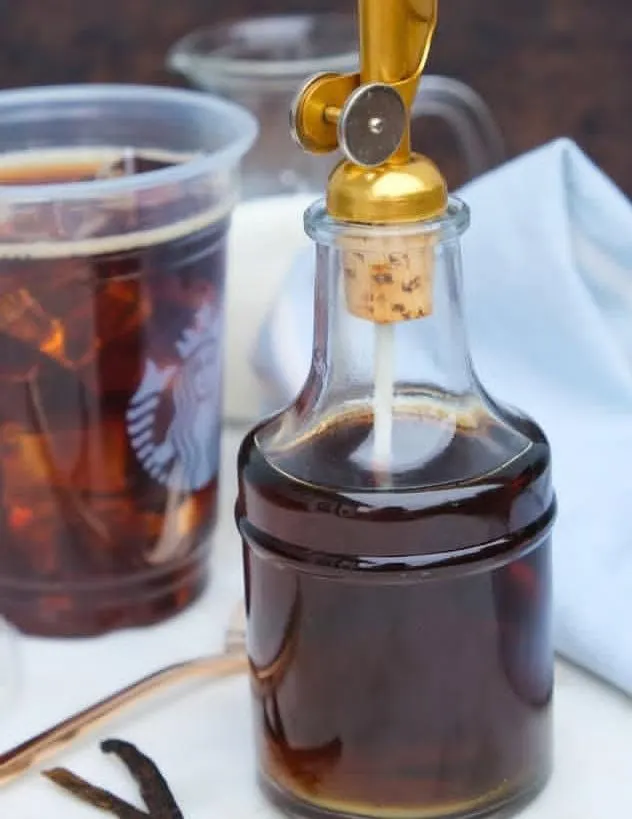
How to Prepare — Step-by-Step
Begin by assembling and measuring all ingredients. Split a vanilla bean lengthwise and scrape the seeds into a small bowl if using a bean; measure two tablespoons of pure vanilla extract if not. Brew a strong espresso shot or dissolve instant espresso into 60 milliliters of hot water and set aside to cool slightly. Measure 400 grams of granulated sugar and 480 milliliters of filtered water. Having everything prepped ensures a smooth, continuous cooking process and prevents overheating or delayed additions.
In a medium heavy-bottomed saucepan combine the sugar and water. Warm the mixture over medium heat, stirring gently to dissolve the sugar completely. Do not allow the mixture to boil vigorously initially; a gentle simmer is sufficient. Once sugar is fully dissolved, increase heat slightly until a steady gentle boil forms, then reduce heat to maintain a simmer. The sugar-water stage creates the simple syrup foundation that will carry vanilla and coffee flavors.
Add the scraped vanilla seeds and the split pod (if using a bean) into the simmering syrup, or pour in the pure vanilla extract near the end of cooking to preserve aromatics. Stir in the brewed espresso or dissolved instant coffee, followed by a small pinch of salt. Keep the syrup at a gentle simmer for about 6 to 8 minutes to concentrate flavors, stirring occasionally and skimming any foam that appears. If using corn syrup, stir it in during this stage to integrate and prevent crystallization.
After simmering, remove the saucepan from the heat and let the syrup cool for five minutes to allow flavors to meld. If you used a vanilla pod or any coarse solids, strain the syrup through a fine-mesh sieve or cheesecloth into a clean pouring jug to remove solids. If you prefer to keep vanilla seeds for visual appeal, omit straining and remove only the pod. Taste the syrup and adjust with a touch more vanilla or a teaspoon of vodka if desired for preservation and aroma.
Transfer the syrup into sterilized glass bottles or jars while still warm, seal bottles tightly and allow the syrup to cool to room temperature before refrigerating. Label each bottle with the preparation date and contents. Refrigerated in clean, airtight containers, the standard syrup maintains excellent quality for up to four weeks; adding a small teaspoon of vodka can extend stability slightly. Use within recommended timeframes and discard if off-odors or visible spoilage occur.
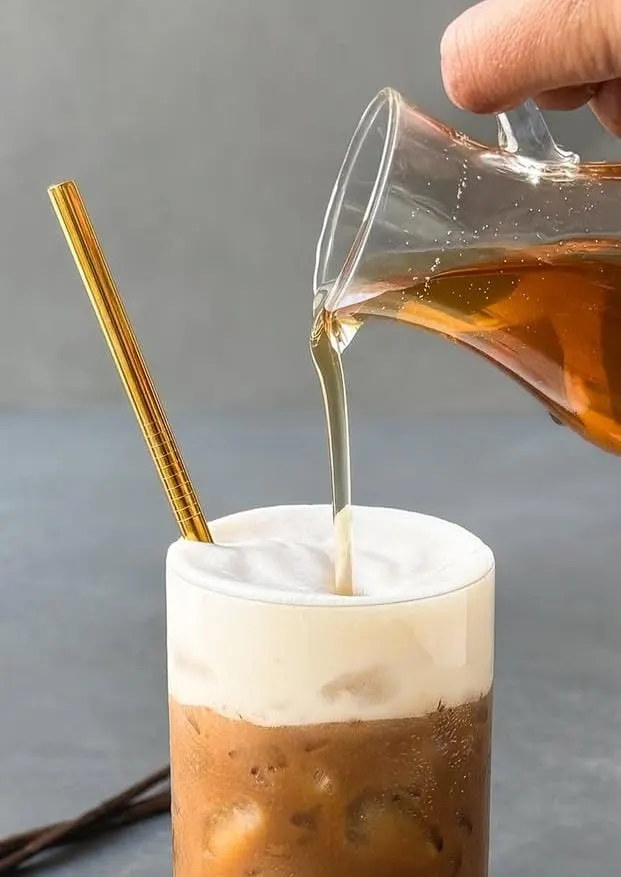
Tips for Texture, Clarity and Avoiding Crystallization
Use a heavy-bottomed pan to distribute heat evenly and prevent local hotspots that may cause sugar to crystallize. Clean the saucepan sides with a pastry brush dipped in water to dissolve any stray sugar crystals.
Adding a small amount of corn syrup or glucose reduces the syrup’s tendency to crystallize and improves shelf stability. Avoid over-boiling; excessive evaporation will thicken the syrup beyond desired pourable consistency. For crystal-free clarity, strain the syrup and store it in airtight glass containers at stable refrigerator temperatures; avoid repeated temperature cycling.

Healthy Habits and Portion Control
Vanilla coffee syrup is high in sugar and should be used judiciously. Use a tablespoon or less per drink, and pair syrup-sweetened beverages with sources of protein like milk or yogurt to slow sugar absorption.
Consider reducing sugar by 20–30 percent and compensating with stronger vanilla or coffee to maintain flavor. Use natural sweeteners—like a portion of maple syrup or honey—instead of some granulated sugar if desired, but be aware that substitutes can change texture and shelf life. Keep syrup refrigerated and label bottles with the date to practice safe consumption and portion control.
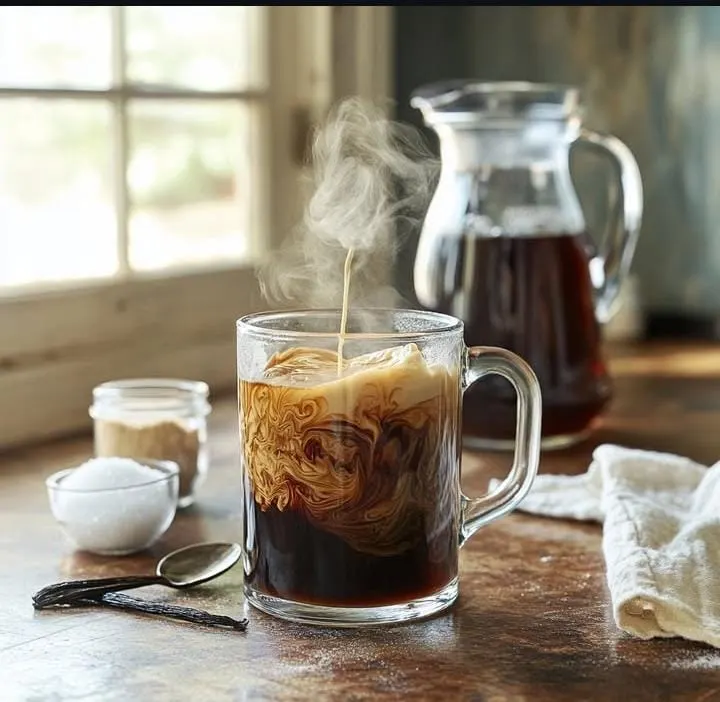
Variations
1. Brown Sugar Vanilla Coffee Syrup
Use 400 grams (2 cups) light brown sugar instead of white sugar for a caramel-forward flavor profile. Brown sugar adds moisture and molasses notes that create a richer, deeper taste that pairs exceptionally well with nutty coffee blends.
In a saucepan combine 2 cups brown sugar and 2 cups water, bring to a simmer and stir in vanilla seeds or extract and 60 milliliters strong coffee. Simmer gently for 6–8 minutes, strain if desired, cool, and bottle. This syrup is excellent in lattes and cold brews and adds complexity to baked goods.
2. Vanilla Bean Cold Brew Coffee Syrup (Low Heat Infusion)
Steep a split vanilla bean in 720 milliliters of cold-brew coffee with 300 grams sugar overnight in the refrigerator. Cold infusion preserves delicate vanilla and coffee aromatics and yields a smoother, less bitter profile compared to hot extraction.
After steeping, strain the mixture through a fine sieve and warm gently to dissolve any undissolved sugar, or leave chilled and stir until sugar dissolves. Bottle and refrigerate; the result is a silky syrup ideal for iced coffee and cocktails.
3. Sugar-Free Vanilla Coffee Syrup (Using Erythritol and Monk Fruit)
Combine 480 milliliters water with 300 grams erythritol and 2 tablespoons vanilla extract; heat gently until erythritol dissolves. Add 60 milliliters concentrated espresso for coffee flavor, simmer briefly, and cool.
Erythritol can crystallize and has a different mouthfeel; adding a small amount of glycerin or a bulking agent like inulin improves texture. Use this syrup sparingly to reduce caloric intake while preserving coffee-vanilla flavor.
4. Spiced Vanilla Coffee Syrup with Cinnamon and Cardamom
Add 1 cinnamon stick and 4 crushed green cardamom pods to the syrup during simmering for warm, aromatic spice notes. These spices complement vanilla and coffee, creating a syrup that evokes café-style seasonal drinks.
Simmer spices with sugar and water for 8 minutes, add coffee and vanilla near the end, strain, and cool. Use in lattes, mochas, and dessert drizzles for a layered spice profile.
5. Vanilla Hazelnut Coffee Syrup
Add 1/2 cup hazelnut praline or toasted hazelnut paste during the simmering stage, or steep toasted hazelnuts in the syrup and strain. Hazelnut pairs naturally with coffee and vanilla for a dessert-like flavor profile.
After simmering with hazelnuts, strain thoroughly to remove solids for a smooth syrup. This variation is perfect for mocha variations and bakery glazes.
6. Bourbon Vanilla Coffee Syrup (Adult Variation)
Replace a teaspoon of vodka with 1 tablespoon bourbon at the end of cooking for smoky oak undertones. Alcohol enhances preservation slightly and adds depth of flavor, but use sparingly.
Add bourbon off heat and allow to cool before bottling; note this version is not suitable for children. Use in coffee cocktails and boozy dessert drinks.
7. Vegan Coconut Vanilla Coffee Syrup
Replace half the water with full-fat coconut milk (240 milliliters) and use 300 grams sugar to create a coconut-vanilla coffee syrup. Coconut adds tropical richness and a creamy mouthfeel suitable for dairy-free lattes.
Heat gently to dissolve sugar and incorporate coffee and vanilla, avoiding vigorous boiling to prevent curdling. This syrup is excellent in iced coconut lattes and pairs with almond or oat milk.
Storage and Shelf Life
Store vanilla coffee syrup refrigerated in sterilized airtight glass bottles. When made with plain sugar, vodka, or proper hygiene, the syrup will keep for up to one month in the refrigerator. Sugar-free versions and those made with alternative sweeteners may have different shelf lives; follow manufacturer guidance. For extended storage, freeze in ice cube trays and thaw as needed; frozen syrup cubes can be added directly to hot beverages.
Equipment Needed
You will need a medium heavy-bottomed saucepan, fine-mesh sieve or cheesecloth, sterilized glass bottles or jars with tight lids, measuring cups and spoons, a wooden spoon or heatproof spatula, and optionally a candy thermometer to monitor temperature and avoid over-reduction.
Troubleshooting Common Problems
If syrup crystallizes, warm gently and stir in a teaspoon of corn syrup or glycerin to re-dissolve crystals, then cool and store airtight. If syrup is too thin, simmer a few more minutes; be cautious not to over-reduce. If flavor is too flat, add a small amount of brewed espresso or more vanilla extract to intensify. If too sweet, dilute with water or use the syrup sparingly in drinks. If cloudiness occurs, double strain through a fine sieve and then a coffee filter to remove fine solids.
How to Use Vanilla Coffee Syrup
Add 1 tablespoon to 8 ounces of coffee or milk for a balanced sweetness; adjust to taste. Mix into cold brew, iced lattes, cappuccinos, or drizzled over desserts like panna cotta and ice cream. Use as a glaze for cakes and pastries or in cocktails and mocktails. The syrup also enhances oatmeal, yogurt, and pancakes when used as a flavoring drizzle. For baking, reduce other liquids slightly when substituting part of the sugar with syrup.
Nutrition Snapshot
Approximate per tablespoon (15 ml) of the standard syrup: 50–60 calories, 13–15 grams carbohydrates (all sugars), 0 grams protein, 0 grams fat. Variations with added milk or coconut will increase calories and fat. Sugar-free versions have negligible calories but may contain sugar alcohols that affect digestion for some individuals. Always account for added calories when adding syrup to multiple daily beverages.
Pairings and Serving Ideas
Pair vanilla coffee syrup with cold brew for a smooth iced drink or with steamed milk for a classic vanilla latte. Drizzle over vanilla ice cream or use in affogato-style desserts where a shot of espresso is poured over gelato sweetened with syrup. Combine with chocolate for mocha versions or with caramel for layered dessert sauces. For brunch, add a dash to pancake batter or mix into whipped cream for a flavored topping.
Safety and Allergen Notes
Be mindful of nut-based variations like hazelnut syrup for those with allergies. Label homemade bottles with ingredients and date. When using alcohol in recipes, note that the final product will contain trace alcohol and is not suitable for children or those avoiding alcohol. Maintain proper sanitation during preparation to reduce microbial contamination, especially when using dairy-based ingredients in variations.
Advanced Tips and Professional Touches
For the clearest syrup, clarify by straining through a coffee filter after an initial fine-mesh sieve. For richer vanilla aroma, macerate vanilla beans in sugar for 24 hours before making syrup. Use high quality espresso roast and pure vanilla extract to elevate the flavor. For gloss and texture, a small percentage of glucose or invert sugar creates a professional mouthfeel. If selling or gifting, hot-fill and invert bottles to create a vacuum seal and extend shelf life.
In-Depth Preparation Notes and Timing
Preparing vanilla coffee syrup benefits from attention to timing and gentle heat. Measure ingredients precisely with a kitchen scale for consistent results. The process from start to finish typically takes about 20 to 25 minutes plus cooling time, but most of that is passive simmering and cooling. Begin by prepping the vanilla and coffee while the water heats, and use the simmering window to combine flavors without aggressive boiling. Cooling time can be shortened by transferring the hot syrup into shallow, sanitized containers to dissipate heat more quickly before bottling.
The Science of Syrup and Flavor Extraction
Flavor extraction follows simple diffusion principles: heat increases molecular motion, allowing sugar and water to carry aromatic compounds from vanilla and coffee into solution. Vanilla beans contain vanillin and other volatile phenolic compounds that dissolve readily into warm aqueous alcohol solutions and into hot sugar water. Coffee oils and soluble compounds like chlorogenic acids and melanoidins dissolve differently depending on temperature; concentrated espresso provides a robust coffee signature with fewer tannins than long steeping. Controlling temperature preserves desirable volatiles and prevents bitter over-extraction.
Scaling the Recipe and Batch Considerations
This recipe scales linearly for larger batches, but practical limits exist. Doubling the batch requires a pot with adequate surface area to ensure even heating; larger volumes heat more slowly, increasing extraction time. Use the same sugar-to-water ratio and adjust simmering time as needed, tasting periodically. When scaling up for gifts or small business use, follow strict sanitation and consider pasteurization steps: heat the syrup to 85°C (185°F) for a minute then hot-fill sterilized bottles to reduce microbial risk. Document batch dates and ingredients to ensure traceability.
Recipe Card — Quick Reference
- Granulated white sugar: 400 g (2 cups)
- Filtered water: 480 ml (2 cups)
- Brewed espresso: 60 ml (1/4 cup) or 2 tbsp instant espresso
- Pure vanilla extract: 2 tbsp or 1 vanilla bean, split and scraped
- Corn syrup (optional): 1 tbsp
- Pinch of salt: 1/16 tsp
Yield: ~720 ml (3 cups). Prep: 10 minutes. Cook: 8–10 minutes. Cool: 20–30 minutes.
Frequently Asked Questions
Can I use artificial vanilla flavor? Artificial vanilla (vanillin) can work in a pinch, but pure vanilla extract or real beans provide richer, more complex flavor. How long will it keep unrefrigerated? Homemade syrup should be refrigerated; unrefrigerated storage increases spoilage risk. Can I double-strain for clarity? Yes, passing syrup through a coffee filter after a mesh sieve improves clarity and removes fine particulates. Will syrup ferment? If contaminated or improperly stored, sugar-rich syrups can ferment; refrigeration and bottles with tight seals minimize that risk.
Flavor Pairing and Recipe Uses Expanded
Vanilla coffee syrup enhances baked goods: brush thin layers on cake sponges for added moisture and flavor before assembling multi-layer cakes. Fold into whipped cream for an aromatic topping or mix into mascarpone to create a flavored filling for tiramisu and cream puffs. In cocktails, vanilla coffee syrup pairs with aged rums, bourbon, and coffee liqueurs to create balanced, aromatic drinks. In baking, substitute part of the sugar in recipes with syrup for a nuanced, moist crumb and light vanilla-coffee notes.
Small Business and Gifting Tips
If producing syrup as gifts or for sale, invest in amber glass bottles to reduce light exposure and extend shelf life. Design clear labels that include ingredients, allergen warnings, and a “best by” date. For market stalls, offer sample cards and small trial sizes to encourage purchases. Consider offering flavor bundles—classic vanilla, hazelnut, and spiced—so customers can experiment. Comply with local food safety regulations if selling commercially, including proper labeling and kitchen certification.
Cultural Notes and Creative Inspiration
Coffee and vanilla have deep culinary histories: vanilla originates from Mesoamerica and became a prized flavor worldwide, while coffee’s roasting and brewing traditions evolved in Ethiopia, the Arabian Peninsula, and Europe. Combining these two ingredients in syrup form draws on global influences and contemporary café culture. Use the syrup to create signature house drinks—try a “Vanilla Coffee Affogato” with two tablespoons of syrup over a scoop of vanilla gelato topped with hot espresso, or a “Vanilla Cold Brew Float” with chilled cold brew, a splash of syrup, and a scoop of coconut ice cream.
Environmental and Ingredient Sourcing Advice
Choose ethically sourced vanilla and coffee whenever possible. Single-origin vanilla and fair-trade coffee support sustainable farming practices and often offer superior flavor. Buying whole vanilla beans and grinding or scraping them yourself reduces packaging waste. Consider using organic sugar and recyclable glass bottles to lessen environmental impact. Small sourcing decisions contribute to flavor and sustainability over time and reflect thoughtful stewardship of resources.
Final Serving Suggestions and Creativity
To serve, offer syrup tableside with milk and cold brew so guests can customize sweetness. Create flight samplers featuring classic syrup paired with cold brew, oat milk latte, and a chocolate ganache for comparative tasting. Experiment by infusing additional botanicals like orange peel or toasted coconut during simmering for seasonal limited editions. Keep a small bottle beside your espresso machine for daily use and to impress visitors with café-quality flavored beverages.




